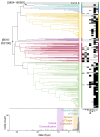Ancient Genomes From Bronze Age Remains Reveal Deep Diversity and Recent Adaptive Episodes for Human Oral Pathobionts
- PMID: 38533900
- PMCID: PMC10966897
- DOI: 10.1093/molbev/msae017
Ancient Genomes From Bronze Age Remains Reveal Deep Diversity and Recent Adaptive Episodes for Human Oral Pathobionts
Abstract
Ancient microbial genomes can illuminate pathobiont evolution across millenia, with teeth providing a rich substrate. However, the characterization of prehistoric oral pathobiont diversity is limited. In Europe, only preagricultural genomes have been subject to phylogenetic analysis, with none compared to more recent archaeological periods. Here, we report well-preserved microbiomes from two 4,000-year-old teeth from an Irish limestone cave. These contained bacteria implicated in periodontitis, as well as Streptococcus mutans, the major cause of caries and rare in the ancient genomic record. Despite deriving from the same individual, these teeth produced divergent Tannerella forsythia genomes, indicating higher levels of strain diversity in prehistoric populations. We find evidence of microbiome dysbiosis, with a disproportionate quantity of S. mutans sequences relative to other oral streptococci. This high abundance allowed for metagenomic assembly, resulting in its first reported ancient genome. Phylogenetic analysis indicates major postmedieval population expansions for both species, highlighting the inordinate impact of recent dietary changes. In T. forsythia, this expansion is associated with the replacement of older lineages, possibly reflecting a genome-wide selective sweep. Accordingly, we see dramatic changes in T. forsythia's virulence repertoire across this period. S. mutans shows a contrasting pattern, with deeply divergent lineages persisting in modern populations. This may be due to its highly recombining nature, allowing for maintenance of diversity through selective episodes. Nonetheless, an explosion in recent coalescences and significantly shorter branch lengths separating bacteriocin-carrying strains indicate major changes in S. mutans demography and function coinciding with sugar popularization during the industrial period.
Keywords: Streptococcus mutans; Tannerella forsythia; ancient pathogen genomics; microbial evolution; oral microbiome.
© The Author(s) 2024. Published by Oxford University Press on behalf of Society for Molecular Biology and Evolution.
Conflict of interest statement
Conflict of Interest: The authors declare no competing interests.
Figures



Similar articles
-
Analysis of oral microbiome from fossil human remains revealed the significant differences in virulence factors of modern and ancient Tannerella forsythia.BMC Genomics. 2020 Jun 15;21(1):402. doi: 10.1186/s12864-020-06810-9. BMC Genomics. 2020. PMID: 32539695 Free PMC article.
-
Metagenomics of the modern and historical human oral microbiome with phylogenetic studies on Streptococcus mutans and Streptococcus sobrinus.Philos Trans R Soc Lond B Biol Sci. 2020 Nov 23;375(1812):20190573. doi: 10.1098/rstb.2019.0573. Epub 2020 Oct 5. Philos Trans R Soc Lond B Biol Sci. 2020. PMID: 33012228 Free PMC article.
-
Comparative genome characterization of the periodontal pathogen Tannerella forsythia.BMC Genomics. 2020 Feb 11;21(1):150. doi: 10.1186/s12864-020-6535-y. BMC Genomics. 2020. PMID: 32046654 Free PMC article.
-
[Streptococcus mutans and oral streptococci in dental plaque].Can J Microbiol. 2011 Jan;57(1):1-20. doi: 10.1139/w10-095. Can J Microbiol. 2011. PMID: 21217792 Review. French.
-
The Caries Microbiome: Implications for Reversing Dysbiosis.Adv Dent Res. 2018 Feb;29(1):78-85. doi: 10.1177/0022034517736496. Adv Dent Res. 2018. PMID: 29355414 Review.
Cited by
-
Influence of betel nut chewing on oral microbiome in Papua New Guinea.Evol Med Public Health. 2024 Nov 9;13(1):36-44. doi: 10.1093/emph/eoae030. eCollection 2025. Evol Med Public Health. 2024. PMID: 40124740 Free PMC article.
References
-
- Adler CJ, Dobney K, Weyrich LS, Kaidonis J, Walker AW, Haak W, Bradshaw CJA, Townsend G, Sotysiak A, Alt KW, et al. Sequencing ancient calcified dental plaque shows changes in oral microbiota with dietary shifts of the Neolithic and Industrial revolutions. Nat Genet. 2013:45(4):450–455. 10.1038/ng.2536. - DOI - PMC - PubMed
MeSH terms
Grants and funding
LinkOut - more resources
Full Text Sources

